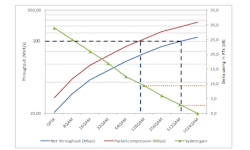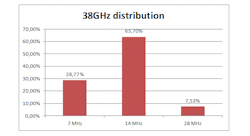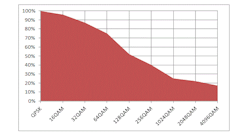Scaling capacity is a critical aspect in managing communications networks. Exponential growth of user-generated traffic is impacting mobile networks, as bandwidth-hungry smartphones and wireless tablets become more commonplace. Microwave technology is used extensively in mobile backhaul networks, and it is certainly not immune to the effects of this ever-growing demand for bandwidth. As a result, scaling the capacity of these microwave networks is an essential part of their overall operational management, both at the radio and at the packet layer—this latter domain being specific to packet microwave systems.
Related Articles
• The Network of Tomorrow Takes Shape
• SoCs Power Wireless Sensor Networks
• Cellular Networks Get Primed For Tomorrow
Modern microwave networks can no longer be managed by optimizing spectrum efficiency on a link-by-link basis. A network-based approach is mandatory. Such an approach avoids performing optimizations that are only valid on a small scale. It also helps network operators to pursue a reduction in the quantity of spectrum used, which leads to a savings in the associated rights of use paid by operators for a certain spectrum allocation. To better understand effective microwave network management, Alcatel-Lucent performed analysis on two strategies to scale network capacity, modeling different scenarios on an operational microwave network. The results reveal how scaling capacity can be managed for more effective network operation.
Analyzing Capacity Mechanisms
The two strategies are based on different technologies. The first is based on high-order quadrature amplitude modulation (HQAM), using higher-order modulation to maximize spectrum efficiency over a microwave communications channel. The second strategy employs packet compression mechanisms; in a full packet-based environment, compression reduces the overhead introduced by a frame or packet structure for microwave transmission, contributing to an increase in spectral efficiency.
HQAM is designed to increase the density of modulation symbols in a transmitted constellation. If 256-state quadrature amplitude modulation (256QAM) is considered a reference format, then 512QAM and 1024QAM formats can provide combined sequential gain of about 25% in useable traffic capacity compared to the reference. Meanwhile, 2048QAM and 4096QAM formats can deliver improvements on the order of an additional 15% over 512QAM and 1024QAM.
Packet compression acts at all layers of an Internet protocol (IP) packet. In the process, several fields belonging to Ethernet, Multiprotocol Label Switching (MPLS), IP, and the upper-layer header are stripped prior to transmission and rebuilt at the receiving end of a microwave link. This saves on the number of bits sent across the link. The effectiveness of packet compression depends on the traffic mix and conditions, making it difficult to calculate an average figure. For an Internet mix (IMIX) traffic profile1 based on IPv4, if the gain is on the order of 30% to 40%, it is almost doubled for a similar profile based on IPv6 capacity increase (see, for example, ref. 2). As the transition in networks is made from IPv4 to IPv6, scaling gains brought about by packet compression will become even more significant.
Link Versus Network Spectrum Efficiency
Spectrum efficiency is often measured on isolated links, where “isolated” refers to a link that is not impaired by interference or disturbance by neighbor radios, and is itself not a source of interference. Unfortunately, this provides information under ideal conditions and not under realistic network conditions, where interference may be commonplace. The goal of practical network design does not coincide with optimization of a single link. An optimal network design should provide requested capacity with minimal occupied spectrum. The reason for this is twofold: spectrum is a limited resource, and spectrum has an associated price for its use. With less spectrum used,more savings in operating expenditure (OPEX) are realized for a network.
This network analysis approach helps network operators to more practically use the spectrum they own: reusing frequency, avoiding unused portions of spectrum, and minimizing generation of interference so that neighboring links or networks are not impaired. The network approach (rather than the single-link approach) poses more constraints on increasing capacity, since a decision on increasing the modulation format would be based more on knowledge of the environment than in the past. For example, such knowledge would imply to avoid the use of higher-order modulation formats at dense nodal/hub points or locations most exposed to impairment, while last-mile links are less affected.
Analyzing Capacity Increases
To better understand how higher-order modulation and packet compression can impact scaling capacity in wireless communications networks, an operational European mobile backhaul network was analyzed. It consists of 890 links. The largest group of these, comprised of 146 links, falls into the 38-GHz band and includes both last-mile connections (or “tails”) and nodal links. The analysis was performed in order to:
1. Define the “theoretical” maximum throughput possible in the network, which will help determine the maximum capacity supported by the network without touching any network components.
2. Determine the limits of the network before redesign is needed to support HSPA+/Long Term Evolution (LTE) services.
3. Provide a guideline for adopting a technology or combination of technologies that can increase network capacity.
1. This graph shows the distribution of channels in the 38-GHz frequency band.
Figure 1 shows the 38-GHz communications band and how channels are distributed across that portion of the frequency spectrum. It is also a starting point for this network analysis. According to current spectrum utilization, the total throughput offered by the microwave network as a whole is around 1.9 Gb/s. All links employ fixed modulation to support a network availability equal to 99.999% (5 minutes outage per year). From this starting point, two strategies—HQAM and packet compression—are analyzed to scale capacity with the limitation that incremental capital expenditure (CAPEX) and OPEX is avoided.
Scaling Capacity Using HQAM
To model the HQAM approach, the modulation index was increased from the reference modulation level currently employed to the maximum level possible to reach 99.995% uptime. Each modulation scale introduces more capacity, but not all links can reach the maximum modulation scheme because of link length and interference scenarios. Thus, the approach taken represents a sort of tradeoff between modulation scheme scale and network spectrum efficiency (see refs. 4 and 5 for more details). By adopting this method across the entire experimental network, the total capacity increased to 7 Gb/s, or a four-fold improvement.
2. This plot shows the distribution of modulation indexes in the population under analysis.
Figure 2 shows the percentage of links (both last mile and nodal) for which a certain modulation index is achievable. A modulation rate of 128QAM represents the level after which less than 50% of links can sustain a further increase. With a 1024QAM format, that percentage goes down to 25%. For modulation formats higher than 1024QAM, the probability to support a higher modulation keeps declining, but less steeply.
Some additional findings from this analysis include the following:
1. While 64QAM can be achieved in most of the network, for rates of 128QAM and higher it is critical to determine whether the link is in aggregation (node) or last mile. In most cases, 128QAM and higher-order modulation formats cannot be employed in nodes unless changes are applied (e.g., bigger antennas, antenna class upgrade, link geometry variation).
2. Areas where 1024QAM and higher-order formats are applicable are constituted by last-mile links (tails). Looking specifically at this subset, 4096QAM can be achieved when the link length does not exceed 600 m, while 1024QAM can be sustained for link lengths to about 1 km.
Scaling Capacity Using Packet Compression
Packet compression gains are directly linked to the length and types of packets being carried. Once the packet traffic composition or profile is known, the gain offered by packet compression mechanisms can be expressed as a percentage representing the increase in capacity. Knowledge of traffic profile is indispensable since the gain resulting from packet compression is a function of packet length: the smaller the packet, the higher the gain. This aspect is particularly important in mobile backhaul applications, where voice traffic originates in very small packets (64 to 128 B). The packet-compression analysis is based on a conservative assumption: a traffic distribution close to IMIX profile,1 carried through IPv4 and with traffic steering based on virtual local area network (VLAN) (with a double VLAN TAG). Based on these assumptions, a gain of around 40% can be achieved, bringing total network capacity from 1.9 Gb/s to around 2.7 Gb/s.
3. Packet compression gain is compared here to net throughput and system gain for modulation formats through 1024QAM.
Figure 3 contrasts packet compression versus pure net throughput obtained by scaling the modulation index in a 14-MHz channel. For simplicity’s sake, 1024QAM is the maximum modulation displayed. The gain in capacity provided by packet compression, when compared to the net radio capacity, is represented by the solid red curve. Two conclusions can be immediately derived:
1. Given a certain capacity value (such as 100 Mb/s, represented by the dashed, dark blue line), that capacity can be provided using a lower modulation index (in this example, 128QAM instead of 512QAM) when packet compression is used.
2. A lower modulation scheme implies less transmitted power (in this example, 5-dB less power, represented by the difference between the two dotted orange lines), enabling energy saving while reducing dangerous RF pollution and the overall interference scenario in the network.
Summarizing The Analysis
This analysis has highlighted some key considerations for microwave network design.
The results obtained by means of increased HQAM levels can be considered as a network average. As noted, 128QAM represents the modulation index beyond which there is a strong applicability decline. This is an issue in network aggregation, where a network upgrade or redesign can have significant impact. Even in the tail parts of a network, application of 1024QAM and higher-order modulation formats must be carefully considered, unless service availability is not the primary concern (such as a move from 99.995% availability to 99.99%).
In reality, it may make little sense to scale aggregation links already operating at 64QAM to 128QAM to higher-order modulation formats, since those links are generally designed to operate at 99.999% because of their functionality of grooming traffic in the middle of the network. The main potential to improve modulation rests with the tail portions of the wireless networks, where HQAM can be exploited.
If an increase in the modulation index is the primary means scaling capacity, that choice provides a certain level of uncertainty: for example, given a certain link, there is not full confidence to reach the desired capacity level because of the network status. An alternative solution to HQAM, with a higher degree of confidence in terms of feasibility deployment, is Cross-Polar Interference Cancelation (XPIC): This option has not been considered in the current analysis but provides a 2X increase with larger applicability in a network, at the cost of new equipment. Given the characteristics of the network analyzed, packet compression provides “only” a 1.4X gain, but with the significant advantage that it can be applied everywhere without any changes to the physical network.
Related Articles
• The Network of Tomorrow Takes Shape
• SoCs Power Wireless Sensor Networks
• Cellular Networks Get Primed For Tomorrow
The question that might arise at this point is “which is the best technology?” Unless network specifics constrain an operator to prefer one mechanism, the best solution might employ a mix of technologies to achieve different requirements of network domains and services. For example, in network aggregation where interference might be a serious issue, the combined use of XPIC and packet compression provides a nominal gain close to 2X x 1.4X, a factor 3X from the pure application of HQAM and ready to support the launch of LTE services.5
In summary, two independent technologies have been examined which can be applied at the same time to scale microwave link and/or network capacity. Modern microwave networks will increasingly require the joint application of even more microwave optimization technologies to sustain the backhaul demands of the new generations of RAN technologies such as LTE, small cells, and LTE-Advanced (LTE-A) wireless communications. Packet-based scaling technologies will play an increasingly important role in microwave transmission: They support scaling capacity in existing RF/microwave networks without impacting microwave CAPEX and/or OPEX. These technologies will be further detailed in subsequent articles. One of these articles will examine packet compression algorithms, while another will review multichannel technologies and efforts to reach a capacity threshold thought as unconceivable only a few years back: 10 Gbit/s over the air.
Acknowledgments
The author wishes to greatly thank his colleagues Roberto Valtolina and Mario Frecassetti, both Product Managers of the Microwave Business Unit of Alcatel-Lucent, and Scott Larrigan of Product Marketing, for their precious support.
References
1. “Test Methodology Journal: IMIX (Internet Mix) Journal.”
2. “Packet Microwave: Boosting Capacity For Long-Term Growth.”
3. ITU-R SM.1046-2, “Definition of spectrum use and efficiency of a radio system,” May 2006.
4. ETSI ATTMTM4(12)000056, “Energy efficiency models,”Alcatel-Lucent contribution to TR 103 820 “Energy efficiency metrics and test procedures for point-to-point fixed radio systems.”
5. L. Steenkamp, “Mobile capacity solution,” France Telecom/Orange presentation at Packet Microwave Forum, October 2012.
About the Author
Paolo Volpato
Product Strategy Manager, Wireless Transmission
Since 2008, Paolo Volpato has served as Product Strategy Manager at Alcatel-Lucent. His function deals with the evolution strategy and positioning of the company's microwave product portfolio. His interests include networking and mobile backhauling, specifically in the Long-Term-Evolution (LTE) domain.



